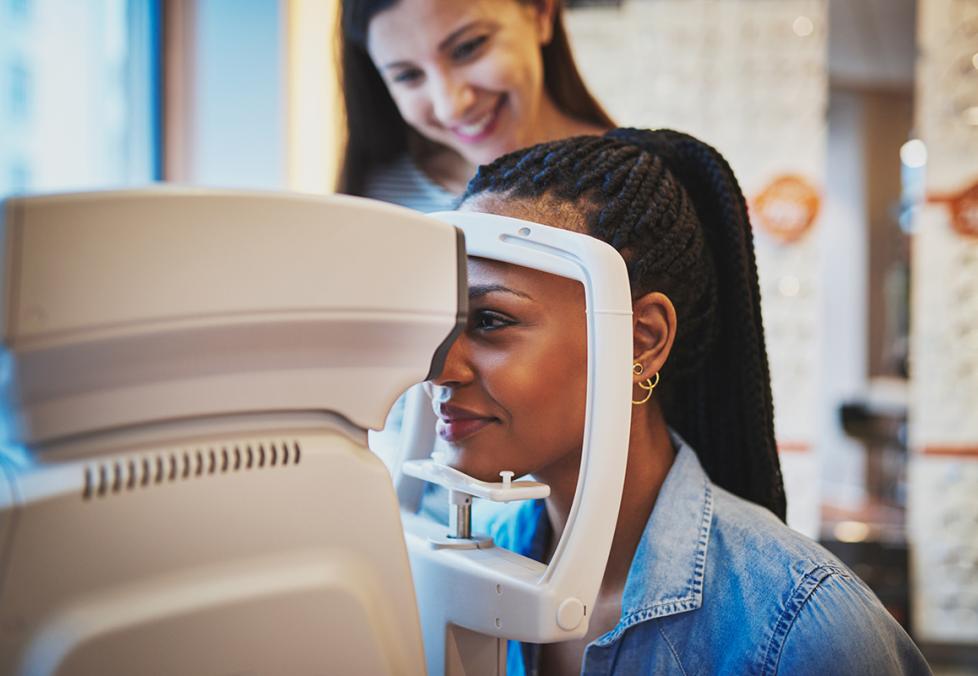
Two pairs and a free, quality eye exam for just $79.95
Everything you need to know to take care of your eyes — for life.
Most people think of vision problems as struggling to make out faraway objects. But farsightedness affects your close-up vision. Here’s what you need to know.

When you think of vision problems, myopia probably comes to mind first. Also known as nearsightedness, it means you have trouble seeing faraway objects, such as street signs or the chalkboard at the front of the classroom.
But there is another refractive error to know about: hyperopia, or farsightedness.
Marked by difficulty seeing up close, hyperopia is less common. If you have blurry vision when trying to watch a video on your cell phone or you get headaches after reading a book, you might want to get checked for hyperopia.
Even if you’ve always had good vision, you might have this vision condition without knowing it. Read on to learn everything you need to know about hyperopia, including how to correct it.
Has it been a while since your last eye exam? Now’s the time to book an appointment!
Hyperopia is a type of refractive error in which the eye doesn’t focus light at the optimal point on the retina in order to see clearly up close.
“If the light focuses behind the retina, then you're dealing with hyperopia or farsightedness,” says Vinh Vu, O.D. an optometrist with America’s Best Contacts & Eyeglasses in Aurora, Colorado. That can happen if your eyes are shorter than normal (measured from back to front) or if your cornea (the clear layer at the front of your eye) is flatter than average.
Only about 5% to 10% of Americans are farsighted, versus nearly 30% who are nearsighted.
Most babies are mildly farsighted at birth but quickly grow out of it, according to the National Institutes of Health.
People with hyperopia have blurry vision when looking at objects up close, but their distance vision is clear. Children with hyperopia might not know they aren’t seeing well, but you may notice them squinting to see nearby objects.
Other hyperopia symptoms include:
“It’s like when you go to take a picture with your phone and click on an image and it goes in and out of focus until it finally settles. That can happen with hyperopia, especially when you’re tired,” says Dr. Vu.
If you have any of these symptoms, you may have hyperopia and not know it. Your eyes may be working harder to focus, and like any muscle, they can get strained or fatigued, says Dr. Vu.
During a comprehensive eye exam, your optometrist will evaluate your vision in a variety of ways.
They will measure how light is reflected inside your eye, either by looking into your eyes with a handheld device or asking you to look into a machine called an autorefractor. This helps determine your prescription, or refractive error.
You will also be asked to read letters and numbers on an eye chart, and your doctor will have you look through a phoropter, another machine that helps determine your prescription.
Hyperopia can happen to anyone. Farsighted people are usually born with this refractive error. It’s the most common refractive error in childhood, and it’s often missed in school screenings.
Children of people who are farsighted are more likely to be farsighted, but having a parent with hyperopia doesn’t guarantee you will have it too, according to the American Academy of Ophthalmology.
If you are diagnosed with hyperopia, you can wear prescription eyeglasses to correct your vision. Contact lenses are also an option. You can work with your doctor to determine the type that is right for you.
But if your farsightedness is very mild and you’re not bothered by it, there is not much harm in doing nothing, says Dr. Vu. “We really want to focus on the symptoms,” he says. If you’re on a computer a lot of the day, if you’re getting headaches and your eyes are tired at the end of the day or you feel like you can’t read for very long, corrective lenses can help relieve the stress on your eyes.
Mild farsightedness can also be treated with laser eye surgery, which reshapes the cornea. For more severe cases, refractive lens exchange surgery may be an option. The procedure replaces your natural lens with an artificial one.

Two pairs and a free, quality eye exam for just $79.95
“It really just depends on the patient, the symptoms, and what their demands are,” says Dr. Vu.
For students and people whose careers focus on computer or other close-up work, wearing reading glasses only as needed is perfectly fine, says Dr. Vu. People who change between close viewing and distance all day long, like teachers, may want to wear glasses with a light prescription. That way, you won’t have to keep taking your glasses on and off.
Hyperopia and presbyopia are both refractive errors that make it difficult to see things clearly up close, but they are a bit different from each other.
Hyperopia has to do with the shape of the eye, and you are usually born with it.
Presbyopia is a normal part of aging that happens to everyone. As we age, the lens of our eye stiffens, thickens, and becomes less flexible, making it harder to focus light correctly on the retina.
If you had normal vision until age 45 and now you find it hard to read the newspaper, you’re likely dealing with presbyopia, not hyperopia.
“Typically, when it gets to that point, that’s when we start talking about bifocal or multifocal progressive corrective lenses that can help see far and close,” says Dr. Vu.
Monovision or multifocal contact lenses are also an option for some people with presbyopia. With monovision, one contact corrects for close vision while the other corrects for distance, if you need it. Multifocal lenses combine near and far vision correction into both lenses. You can work with your doctor to determine the type that is right for you.
“For kids at a younger age, even if they don’t have symptoms, we always recommend a preliminary screening to make sure their eyes are healthy,” says Dr. Vu.
A child can have a high amount of farsightedness but not realize it because they don’t know the difference. Hyperopia in kids can cause them to develop a lazy eye, also called amblyopia, which can lead to permanent vision reduction if not corrected.
Left undiagnosed, hyperopia in children could have real consequences for learning. One study found that young farsighted children had a more difficult time paying attention at school, which could put them at risk of falling behind.
Recommended reading: 3 Vision Problems That School Screenings Often Miss
You can’t do anything to prevent farsightedness. However, Dr. Vu says he encourages his farsighted patients to take extra steps to avoid digital eyestrain. That’s because their eyes may be working harder to focus clearly.
Fortunately, it’s easier than you think to guard against eyestrain. If you’re doing a lot of close-up work, the best thing to do is take regular screen breaks and follow the 20-20-20 rule: For every 20 minutes of reading or screen time, take a 20-second break and look at something 20 feet away.
“That lets our focus relax, reset, and get back to where it needs to be,” says Dr. Vu. “It's good for everybody, especially those with farsightedness.”
Medically reviewed by Vinh Vu, O.D.
See our sources:
Farsightedness facts: National Eye Institute
Myopia overview: American Optometric Association
Study on hyperopia: StatPearls
Hyperopia overview: American Academy of Ophthalmology
Types of refractive errors: National Eye Institute
Study on children with uncorrected hyperopia: Optometry and Vision Science